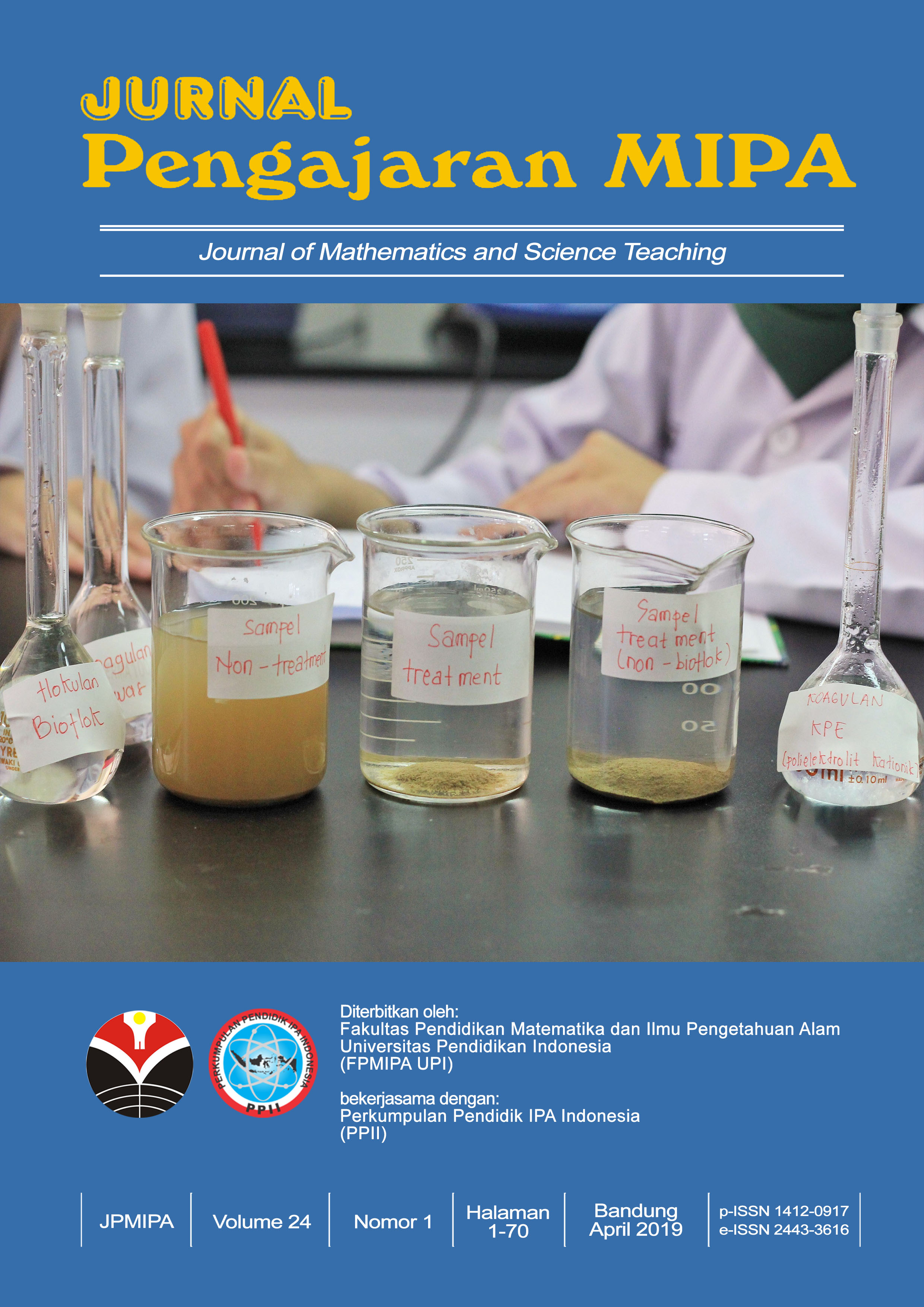PEMBELAJARAN THINK-TALK-WRITE DALAM MENINGKATKAN KEMAMPUAN PEMECAHAN SOAL GEOMETRI
Abstract
Buruknya kemampuan siswa dalam menyelesaikan soal-soal geometri merupakan salah satu permasalahan krusial di bidang pendidikan matematika. Pada penelitian metode campuran ini, strategi pembelajaran ko-operatif Think-Talk-Write digunakan untuk meningkatkan kemampuan siswa kelas VII dalam menyelesaikan soal-soal geometri. Sampel adalah 35 siswa kelas tujuh di salah satu sekolah menengah pertama di Jawa Timur. Instrumen penelitian adalah lembar kerja siswa (LKS), tes tertulis, maupun lembar observasi. Pem-belajaran Think-Talk-Write dilaksanakan dalam dua sesi pembelajaran. Hasil menunjukkan bahwa pembel-ajaran Think-Talk-Write mampu meningkatkan kemampuan siswa dalam menyelesaikan soal-soal geometri, baik soal-soal yang diberikan pada LKS maupun saat tes tertulis. Tahapan-tahapan pada strategi pembelajaran Think-Talk-Write membantu siswa untuk merefleksikan, mengorganisasikan, dan memperbaiki pemahaman-nya sehingga mampu menjawab soal-soal geometri yang diberikan dengan lebih baik. Selain kontribusi dari tahapan-tahapan pembelajaran Think-Talk-Write itu sendiri, guru juga berkontribusi terhadap peningkatan kemampuan menyelesaikan soal-soal geometri khususnya dalam hal mendeteksi dan membimbing siswa untuk mengatasi kesulitan-kesulitan yang mereka alami dalam menyelesaikan soal-soal geometri.
ABSTRACT
Students’ poor ability in completing geometry questions is one of the crucial problems in mathematics edu-cation. In this mixed method research, Think-Talk-Write cooperative learning was used to enhance seventh-grade students’ ability in completing geometry questions. Samples were 35 seventh grade students in one of junior high school in East Java. Instruments were students’ worksheets (LKS), written test, as well as obser-vation sheets. Think-Talk-Write learning was conducted in two learning sessions. Results showed that Think-Talk-Write learning increased students’ ability in completing geometry questions, both in completing ques-tions in the LKS and in the written test. Steps in Think-Talk-Write learning help the students to reflect, orga-nize, and improve their understanding so that they are able to answer the given geometry questions better. In addition to the contribution of each step in Think-Talk-Write learning itself, teacher also contributed to stu-dents’ improved ability in completing geometry questions, especially in terms of detecting and guiding the students’ to overcome difficulties in completing geometry questions.
How to cite: Prayitno, A. (2016). Pembelajaran Think-Talk-Write dalam Meningkatkan Kemampuan Pemeca-han Soal Geometri, Jurnal Pengajaran MIPA, 21(2), 135-141.
Keywords
Full Text:
PDFReferences
Chapin, S.H., O’Connor, C., & Anderson, N.C. (2009). Classroom Discussions: Using Math Talk to Help Students Learn, Grades K-6, 2nd Ed. Sausalito, CA: Math Solu-tions
Chianson, M.M., Kurumeh, M.S., & Obida, J.A. (2010). Effect of cooperative learning stra-tegy on students’ retention in circle geo-metry in secondary schools in Benue Sta-te, Nigeria, American Journal of Scientific and Industrial Research, 2(1), 33-36.
Dunlosky, J., Rawson, K.A., Marsh, E.J., Nathan, M.J., & Willingham, D.T. (2013). Im-proving Students’ Learning With Effective Learning Techniques: Promising Direc-tions From Cognitive and Educational Psychology, Psychological Science in the Public Interest, 14(1), 4-58.
Gal, H., & Linchevski, L. (2010). To See or Not to See: Analyzing Difficulties in Geo-metry from the Perspective of Visual Per-ception, Educational Studies in Mathema-tics, 74(2), 163-183.
Huinker, D. & Laughlin, C. 1996. ”Talk Your Way into Writing”. Dalam Communica-tion in Mathematics K-12 and Beyond, 1996 year book. Reston, VA: The National Council of Teachers of Mathematics, Inc.
Imswatama, A., & Muhassanah, N. (2016). Ana-lisis Kesalahan Mahasiswa dalam Menye-lesaikan Soal Geometri Analitik Bidang Materi Garis dan Lingkaran, Suska Jour-nal of Mathematics Education, 2(1), 1-12.
Junaedi, I. (2012). Tipe Kesalahan Mahasiswa da-lam Menyelesaikan Soal-Soal Geometri Analitik Berdasar Newman’s Error Ana-lysis (NEA), Jurnal Kreano, 3(2), 125-133.
Kementerian Pendidikan dan Kebudayaan Repub-lik Indonesia. (2013). Kompetensi Dasar: Sekolah Menengah Pertama (SMP)/ Mad-rasah Tsanawiyah (MTs). Jakarta: Kemen-terian Pendidikan dan Kebudayaan.
Kirschner, P.A. , Sweller, J. & Clark, R.E. (2006) Why Minimal Guidance During Instruc-tion Does Not Work: An Analysis of the Failure of Constructivist, Discovery, Prob-lem-Based, Experiential, and Inquiry-Ba-sed Teaching, Educational Psychologist, 41 (2), 75-86.
Mullis, I.V.S., Martin, M.O., Foy, P., & Arora, A (2012). TIMSS 2011 International Results in Mathematics. Chessnut Hill, MA: TIM-SS & PIRLS International Study Center Lynch School of Education, Boston Col-lege.
National Council of Teachers of Mathematics. (2000). Principles and Standars for School Mathematics. Reston, VA: The National Council of Teachers of Mathematics, Inc.
Pugalee, D.K. (2004). A Comparison of Verbal and Written Descriptions of Students' Pro-blem Solving, Educational Studies in Ma-thematics, 55(1), 27-47.
Safrina, K., Ikhsan, M., & Ahmad, A. (2014). Peningkatan Kemampuan Pemecahan Ma-salah Geometri melalui Pembelajaran Ko-operatif Berbasis Teori Van Hiele, Jurnal Didaktik Matematika, 1(1), 9-20.
Stein, M.K., Engle, R.A , Smith, M.S. & Hughes, E.K. (2008) Orchestrating Productive Ma-thematical Discussions: Five Practices for Helping Teachers Move Beyond Show and Tell, Mathematical Thinking and Learning,10(4), 313-340.
Sumadiasa, I.G. (2014). Analisis Kesalahan Sis-wa Kelas VIII SMP Negeri 5 Dolo Dalam Menyelesaikan Soal Luas Permukaan Dan Volume Limas, Jurnal Elektronik Pendi-dikan Matematika Tadulako, 1(2), 197-208.
Sumarmo, U., Hidayat, W., Zukarnaen, R., Hami-dah, Ratna, S. (2012). Kemampuan Dan Disposisi Berpikir Logis, Kritis, Dan Kre-atif Matematik : Eksperimen terhadap Siswa SMA Menggunakan Pembelajaran Berbasis Masalah dan Strategi Think-Talk-Write, Jurnal Pengajaran MIPA, 17(1), 17-33.
Tarim, K., & Capar, G. (2015). Efficacy of the Cooperative Learning Method on Math-ematics Achievement and Attitude: A Me-ta-Analysis Research, Educational Sci-ences: Theory & Practice, 15(2), 553-559.
Utami, A.D. (2016). Tipe Kesalahan Mahasiswa Dalam Menyelesaikan Soal-Soal Geometri Berdasar Newman’s Error Analysis (NEA), Jurnal Ilmiah Pendidikan Matema-tika, 4(2), 85-92.
Walmsley, A.L.E., & Muniz, J. (2003). Co-operative Learning and Its Effects in a High School Geometry Classroom, Math-ematics Teacher, 96(2), 112-116.
DOI: https://doi.org/10.18269/jpmipa.v21i2.44267
Refbacks
- There are currently no refbacks.
Copyright (c) 2022 Jurnal Pengajaran MIPA

This work is licensed under a Creative Commons Attribution-ShareAlike 4.0 International License.
JPMIPA http://ejournal.upi.edu/index.php/jpmipa/index is licensed under a Creative Commons Attribution-ShareAlike 4.0 International License
Jurnal Pengajaran Matematika dan Ilmu Pengetahuan Alam (JPMIPA) or Journal of Mathematics and Science Teaching
All rights reserverd. pISSN 1412-0917 eISSN 2443-3616
Copyright © Faculty of Mathematics and Science Education (FPMIPA) Universitas Pendidikan Indonesia (UPI)
View JPMIPA Stats









